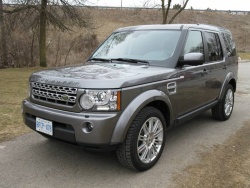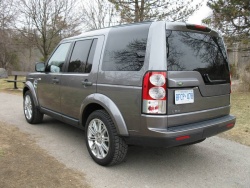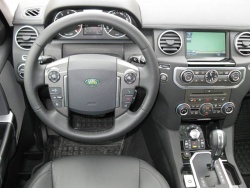 2010 Land Rover LR4. Click image to enlarge |
| Manufacturer’s web site Land Rover Canada |
Review and photos by Jil McIntosh
Find this vehicle in Autos’s Classified Ads
Photo Gallery:
2010 Land Rover LR4
I’ve never been to the United Kingdom, but I’ve seen enough television episodes of Doc Martin and Father Ted to have formed my stereotype: stiff-upper-lipped gentlemen with caps and shotguns, heading out across the moors with their hounds. This requires them to drive a vehicle capable of climbing the white cliffs of Dover, while providing luxury just a few rungs south of what you might expect from Mr. Rolls and Mr. Royce.
This is how I’m trying to figure out Land Rover, and specifically, my LR4 tester. It has a dial for the off-road that I can spin for everything from sand dunes and mud, to climbing over boulders. It has video screens in the back of the head restraints. It has leather seats, and all-around cameras, and a price tag of $77,720. While it’s a very nice and extremely competent vehicle for all that, given that I don’t see too many people in my area heading off to explore their rock-and-heather estates, I have to wonder where its market is. I can’t be alone on that: the company seldom sells more than 200 vehicles a month, including all model lines, for all of Canada. It is, sadly, like many of its SUV brethren: able to leap tall trails at a single bound, but who would ever take a vehicle that expensive anywhere that it might get a scratch on its paint or stones in its tires?
 2010 Land Rover LR4. Click image to enlarge |
Known as the Discovery 4 across the pond, the LR4 is the 2010 evolution of the 2009 LR3. Style-wise, changes include a new grille and lights, including new LEDs, and an updated interior. Chassis tuning and tweaking to the Terrain Response system give it improved handling and off-road ability.
The big change, though, is under the hood. Where the LR3 offered a 4.0-litre V6 or 4.4-litre V8, the 2010 edition comes with a single powerplant: a new 5.0-litre direct-injection V8 that makes matching numbers of 375 horsepower and 375 lb-ft of torque, mated to a six-speed automatic transmission. That’s quite a hike over the previous V8’s figures of 300 horses and 315 lb-ft of torque, but published fuel numbers are virtually the same. That’s even more surprising, given that the LR4 has packed on some serious poundage: while the V8-powered LR3 weighed in at 2,461 kg (5,425 lbs), the LR4 beefs up to 2,646 kg (5,833 lbs) (must be too many deep-fried Mars bars after dinner.)
The new V8 is rated at 17.1 L/100 km (17 mpg Imp) in the city, and 11.6 L/100 km (24) when roaming the countryside. In combined driving, I averaged 17.2 L/100 km (17).
I never had a chance to drive the LR3; indeed, this marks my first time behind a Land Rover’s steering wheel. It’s astonishing that something this heavy can move out this fast. It goes like stink right off the line, and its powerband is fat enough to keep it pulling hard pretty much anywhere on the throttle.
  2010 Land Rover LR4. Click image to enlarge |
It starts at $59,900, which gets you the base model with seating for five. Moving up to the $3,750 HSE Package adds numerous items, including a front parking sensor to complement the rear one on the base model, heated steering wheel, and a navigation system. You need at least the HSE package in order to add the optional third row of seats, which bumps the HSE-plus-seats package to $6,250. The HSE LUX is seven-seater only, for an additional $10,800, while a LUX Plus adds a surround-view camera, for $12,690. Other available options include roof rails, rear-seat entertainment system, a heavy-duty package with active locking rear differential, and the surround camera system as a stand-alone option at $990.
The camera system is primarily meant for off-road driving, although it can come in handy in tight parking lots. It consists of five cameras: one in each exterior mirror, two in the front bumper, and one in the rear. The views show up in the navigation system screen, and different views can be selected, including watching all at once. What’s very odd is that, while I expected to be able to watch them during very low-speed driving where they’d warn of rocks or obstacles on an off-road trail, these displays will continue to run until you turn them off, regardless of speed. I could watch a “movie” of the various views while doing 100 km/h on the highway, which I should think would be considered a distraction. Very usefully, the cameras also mean you can see exactly what you’re doing when you’re hitching up or backing up a trailer.







 Follow Autos on Twitter
Follow Autos on Twitter



